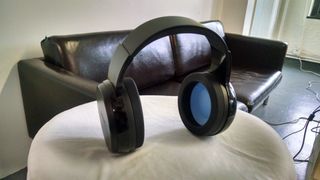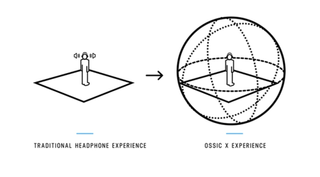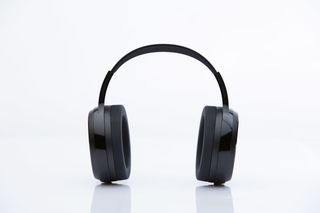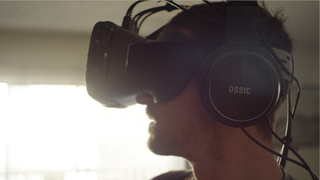Ossic X 3D Audio Headphones To Bring Extra Immersion To VR (Update: $2M On Kickstarter)

Update, 4/14/16, 11:02am PT: Ossic announced that it just crossed the $2 million mark in its Kickstarter campaign, which had an original goal of only $100,000. The campaign ends in just six days, on April 21.
Ossic invited us out to New York City to sample its innovative approach to 3D audio, the Ossic X headset. Although it can certainly improve your run-of-the-mill audio experiences, it's greatest capability is in making VR experiences more immersive.
The Problem With Fully Immersive Audio
Ossic was founded by audio industry veterans from Logitech and Pioneer, with over 50 years of experience in the business combined. The company believes that for the most part, headphones haven’t fundamentally changed in over 65 years, and with audio and visual content becoming more immersive, there is a need for an equally-compelling sound experience.

Ossic said the problem with traditional headphones is that even 3D audio doesn’t take the listener’s anatomy (such as ear shape, head size and the position of your torso) into account when creating the 3D sound stage. All of these factors, which the company calls head-related transfer function (HRTF), affect how we perceive sound in the real world.
Most current 3D audio solutions use a one-size-fits-all method for its algorithms; without a personal calibration of some kind, it translates to a small listening experience, with the sound remaining close to your head rather than around you (as you would hear things naturally). It’s like hearing something through someone else’s ears, and it seems to be hit-or-miss with sound location accuracy and the overall quality.
Developing A Way To Personalize The Experience
Ossic set out to solve these issues by developing a headset that took the listener’s anatomy and HRTF into account to provide an audio experience that increases the user’s sense of auditory space with increased immersion and locational accuracy.


Working in the famous Abbey Road Studios (where a little band called The Beatles once recorded) the team collected data of sound behavior using a large assortment of model heads in all different shapes and sizes, in addition to interchangeable ear molds, in order to develop the means of measuring an individual’s HRTF. The result is a headset with onboard positional tracking that can measure the size of a user’s head, the shape of their ears, and their position in space to produce a 3D audio experience that naturally replicates the way we hear things in the real world.
Stay on the Cutting Edge
Join the experts who read Tom's Hardware for the inside track on enthusiast PC tech news — and have for over 25 years. We'll send breaking news and in-depth reviews of CPUs, GPUs, AI, maker hardware and more straight to your inbox.
Key Features
Eight individual drivers (four in each ear) supply listeners with increased sound localization and sense of presence by directing the audio to the correct portion of your ear. An anechoic ear chamber keeps outside noise isolated, and the padding is removable and washable.

The audio calibration is instant – the sensors are built into the Ossic X and can be turned on or off using a switch to swap between a normal, close-ear audio experience and the immersive 3D sound. The Ossic X also features a boom-less 3D microphone array, which captures a user’s voice without an obtrusive stick in the face.
The Experience
We got to try the Ossic X, and we were impressed with its simplicity, comfort and functionality. The lack of a visible mic lends to the device’s light design, and the Ossic X was comfortable to wear even with an HMD strapped to my face.

As a standalone product (without using a VR headset), the Ossic X can be used to add depth to your music, movie and gaming experiences. Ossic demoed this functionality by playing Dark Side Of The Moon (Dad’s music) with the positional tracking enabled. Swapping between the two modes, it was easy to distinguish the difference – Ossic’s positional tracking and 3D audio algorithms provided an immersive experience that created fixed points of sound that remained perceivable no matter which way I turned my head. It made it sound like Pink Floyd was playing right inside the room.
Ossic showcased its headset’s VR capabilities using an HTC Vive and its immersive Secret Shop demo, which provides plenty of multi-directional sounds to test the device. When connected to a VR headset, the Ossic X interfaces with the positional tracking of the HMD to provide accurately-placed sound. This was a completely new VR experience for me, and I could instantly locate sounds from creatures and events not just to my left or right, but also above, in front and behind me, as well.

In the corner of the VR shop was a set of chimes that you could interact with, so I took the opportunity to test the Ossic X by using the touch controller to ring the chimes while turning away from the source of the sound. From my perspective, the chimes remained in the same auditory space no matter which way I turned (even when I tilted my head), adding even more depth to the immersive experience.

This technology is impressive. As a simple set of 3D headphones for use with music, movies and gaming, the difference in the experience is night and day. Typical left and right panning seems almost droll by comparison, and users don’t need to own an expensive VR headset to appreciate the Ossic X. However, pairing the device to an HMD brings another whole layer of immersion to the VR experience.
Availability
Ossic’s kickstarter campaign is active now, but it will end on April 21 at 11:00am EDT. You can preorder your pair of Ossic X headphones now for $249, but the estimated delivery is January 2017. Early backers already pledged through the company’s expired early bird offer will start seeing their headsets a little earlier, starting in November 2016. When the Ossic X hits retail, the price will rise to $399.
Derek Forrest is an Associate Contributing Writer for Tom’s Hardware and Tom’s IT Pro. Follow Derek Forrest on Twitter. Follow us on Facebook, Google+, RSS, Twitter and YouTube.
-
stevenrix "From my perspective, the chimes remained in the same auditory space no matter which way I turned (even when I tilted my head), adding even more depth to the immersive experience." Sorry but i don't believe that.Reply
-
heliontide What you believe is irrelevant. The headset has tracking so when you turn your head, you can focus in on sounds all around you in every direction. It's going to be huge for VR. Go to their Kickstarter page and watch their video where they go over how it works and what the features are. Maybe hold judgment until you try them yourself. Everyone who has tried them are saying they're incredible and unlike anything they've heard before. I couldn't be any more excited about these. Can't wait to get my hands on them.Reply -
stevenrix No, forgive my laziness, I meant i don't believe this sentence should have been articulated this way, that was my point, it make it sound like there is no immersion at all, this is why i said i don't believe that. I will try this headset in a few months of course.Reply
-
eklipz330 ReplyWhat you believe is irrelevant. The headset has tracking so when you turn your head, you can focus in on sounds all around you in every direction. It's going to be huge for VR. Go to their Kickstarter page and watch their video where they go over how it works and what the features are. Maybe hold judgment until you try them yourself. Everyone who has tried them are saying they're incredible and unlike anything they've heard before. I couldn't be any more excited about these. Can't wait to get my hands on them.
that seems largely unnecessary since the positional tracking within the headset not only assists with the visual, but also the auditory. I find it hard to believe that this pair of headphones is any better than a regular stereo headphone with good sound stage. -
eklipz330 ReplyWhat you believe is irrelevant. The headset has tracking so when you turn your head, you can focus in on sounds all around you in every direction. It's going to be huge for VR. Go to their Kickstarter page and watch their video where they go over how it works and what the features are. Maybe hold judgment until you try them yourself. Everyone who has tried them are saying they're incredible and unlike anything they've heard before. I couldn't be any more excited about these. Can't wait to get my hands on them.
so i went ahead and did a "ossic impressions" google search and came up with one answer: it's snake oil. Bi-naural audio is already amazing and all you need is a decent open back pair of headphones to simulate a large soundstage. you don't need 4 drivers per headset to simulate anything "magical". typical 7.1 marketing under a new nomenclature, "HRTF". what a load of bull. of course "gamers" eat this crap up. -
wifiburger fancy, you can archive the same thing on MTK devices,Reply
MTK have two 3D techs, you can daisy chain them through DSP addresses and DAC addresses, I had this mod on my last MTK device and it gives you a very 360 sounds that jumps across frequencies without any interruptions
, works with small high bandwidth magnets earphones, -
wifiburger you can overwirte the PCM stream with, ONE exampleReply
IN_MTK_BLIVE_IN_MTK_SURR_OUT_Q1P16_OUT_Q1P32
Q1P16 is the 16bit DAC, Q1P32 might be the 32bit DAC too lazy to look at the source code -
thor220 Headphones with more than one driver have been around for awhile now and the issues they had are not addressed in this article. First, getting each driver to work with each other is difficult. I can only imagine the processes they have to go through in the factory to sync the 16 drivers in each pair of these. One of these things out of sync will ruin the experience. 2nd issue is that smaller drivers generally don't have as wide a frequency response and aren't as accurate. I wouldn't expect these to be super detailed or to produce good sounding music.Reply
"3D" sound has been around for awhile and has always failed to catch on due to the issues above. This headset doesn't fix any of those issues and has the gull to be priced the same as top-tier headphones. You have to ask yourself "Is 3D sound really worth all these tradoffs?". -
alidan a long LONG time ago, my brother got me some crappy headphones and some crappy ear buds, a 3 pack for like 5-7$ at school for a christmas present, thought that counts i know, but they are the worst headphones i have ever owned.Reply
im saying that because of this
https://www.youtube.com/watch?v=8IXm6SuUigI
watch that, and close your eyes.
we are already able to track in 3d space with headphones currently, and in a game, if you had a vr setup on, and it was correctly done, you wouldn't ever need more then 2 sources for audio as every turn is tracked correctly and the audio should be adjusted in real time.
and just as a note, i have a pait of hd 598's, this sounds MUCH better through them, but the effect is doable on anything with 2 speakers. -
Alan Pritchard I have been a follower of this project since pre kickstarter, and a first backer.Reply
It sounds like any multi driver headphone, but it is not, the tests i have read reviews on have described it as mind blowing. more than your average gaming headphones.
The developers have tried their best to explain what they are doing, without giving too much away.
one thing they have expressed in interviews,is how very different sound, and positioning is to every person, and how this is processed differently for the individual.
yes, some of it is software, but some of it is hardware. I am yet to hear these but i have my faith in a product that i will be impressed with.
Most Popular


